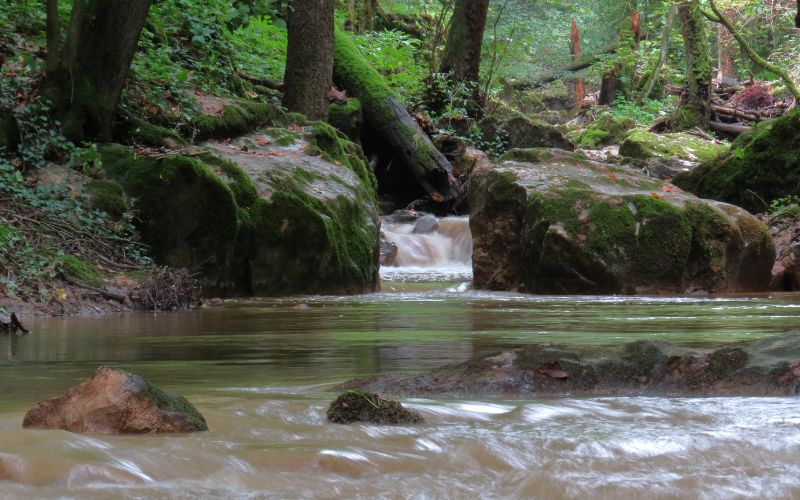Much like diving in clear water, diving in murky water has its own set of dos and don’ts.
Knowing what to do (and not do) can make your dive much more enjoyable and safe.
Here are a few tips to help you dive smarter in murkier waters.
Murky water can make it difficult to see what is ahead, which increases your risk of running into obstacles or becoming lost. It also makes it difficult to spot predators or hazards lurking below the surface. In addition, the sediment and other particles in the water can cause irritation and even respiratory problems if you breathe them in.
Table of Contents
What murky water is and why you should avoid it
If you’re like most people, you probably think of murky water as dirty or polluted.
And while that’s certainly one type of murky water, there’s another kind that scuba divers need to be aware of.
Murky water is simply water that has reduced visibility due to suspended particles.
These particles can be anything from sediment to algae, and they can seriously reduce your ability to see clearly underwater.
That’s why it’s important to take extra care when diving in murky water.
Be sure to check your equipment carefully before entering the water, and always maintain a steady pace so you don’t stir up too much sediment. With a little extra caution, you can safely enjoy diving in even the murkiest of waters.
The dangers of diving in murky water
Diving in murky water can be extremely dangerous, as it significantly reduces visibility and makes it difficult to orient yourself.
This can lead to disorientation and even panic, as you may lose sight of the surface or your dive buddy.
Additionally, murky water is often populated by debris and hazards such as sharp rocks, which can cause injuries if you collide with them.
In addition, water clarity is often an indicator of water quality, so diving in murky water may also put you at risk of encountering pollutants or harmful bacteria.
For all these reasons, it is important to exercise caution when diving in murky water, and to be aware of the risks involved.
Why would you dive in murky water
Despite the dangers, there are still many reasons why scuba divers might choose to dive in murky water.
Murky water can offer a unique and exciting diving experience, as it often contains a greater variety of marine life than clear water.
In addition, some divers find the challenge of diving in murky water to be exhilarating.
If you do choose to dive in murky water, be sure to take all the necessary precautions and go with a experienced guide.
How to dive safely in murky water
When diving in murky water, it is important to take some extra precautions to ensure your safety.
First and foremost, always heed the local dive regulations.
If an area is known for having poor visibility, there may be restrictions in place to protect divers.
Secondly, make sure you have a good dive buddy.
Poor visibility can make it easy to become disoriented, so it is important to have someone who can help keep you on track.
Use a good quality dive light and wear some additional bright or luminous clothing to make yourself more visible to others.
Finally, take care when descending and ascending.
Sudden changes in pressure can cause the water column to collapse, creating a “silt out” situation where visibility quickly deteriorates.
By following these simple guidelines, you can help ensure a safe and enjoyable diving experience in murky waters.
What to do if you get lost or injured while diving in murky water
If you do find yourself in a situation where you are lost or injured while diving in murky water, the most important thing to remember is to stay calm.
If you panic, you will only increase your risk of injuries or becoming further disoriented.
Swimming into the current will help you to maintain your present position and will reduce the chance of you being swept further from your last known location.
Your stream of bubbles can help to determine the direction of the current if this is not obvious.
If you have a dive light, use it to signal for help. If you don’t have a dive light, wave your arms or legs to attract attention.
Reaching the safety of the surface should be a key consideration if you are unable to resolve your situation quickly.
Do not make any ascent faster than a rate of 30 feet (9 m) per minute to help avoid decompression sickness.
If you are with a dive buddy, use the “buddy line” or “leader and follower” system to help maintain contact and stay together.
How to enjoy diving in murky water
Despite the risks, there are still many reasons to enjoy diving in murky water.
For one, it can be a great way to see wildlife that you wouldn’t otherwise have access to.
Many animals are more active at night, so diving in murky water can give you the chance to see them in their natural environment.
Additionally, murky water can provide a unique and challenging diving experience.
Divers who are comfortable in murky water often find that it provides a sense of calm and tranquility, as the reduced visibility can make it feel like you are in your own little world.
Final Words
Diving in murky water can be a unique and exciting experience, as it often contains a greater variety of marine life than clear water.
In addition, some divers find the challenge of diving in murky water to be exhilarating.
If you do choose to dive in murky water, be sure to take all the necessary precautions and go with a experienced guide.




